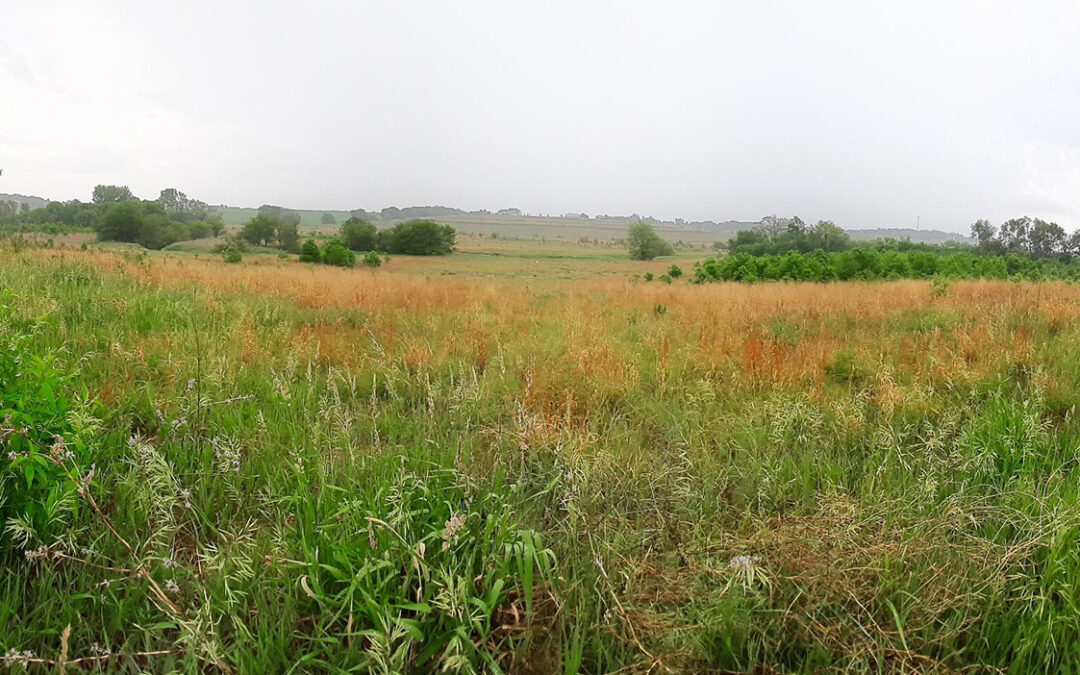Not long ago our area of the Great Plains was a vast, beautiful prairie land, teeming with diverse wildlife and native grasses and plants. We at Valley Corporation are passionate about and committed to helping to restore and protect prairie lands throughout eastern Nebraska.
One-third of Nebraska’s total population live within the Papillion Creek Watershed area. Papio Missouri River Natural Resources District manages the region and we are thrilled to work with them on a variety of projects, including the following, which featured prairie land installations and wetlands habitat.
- Zorinsky Lake (2019) – We relocated around 100,000 yards of dirt upsteam of Zorinsky Lake. As the sediment settles, it allows the clean water to flow downstream. The water basin increases property values, minimizes reservoir maintenance at the lake, improves aesthetics, increases wildlife habitats, improves the aquifer while converting the area from a degraded, disconnected stream habitat to a lake habitat.
- Flanagan Lake – The development includes 475 acres of green space and nearly 100 acres of wetlands, providing a home for migratory birds and fish. Seeded with native plants and grasses while incorporating an upstream water quality basin. The reservoir provides flood protection for Omaha citizens and 730 acres of recreational benefits, such as a 220-acre lake, five-mile hiking/biking trail, and park and green space. Flanagan Lake officially opened to the public on June 27, 2018.
- A new, still-unnamed dam site lake and recreation area is coming to the area adjacent to 180 & Giles Road – In 2021 Valley Corporation dug and relocated tens of thousands of yards of dirt for a large hole and dam, which is a future settling pond. We then handled prairie grass seeding and wetland seeding. Jeff Grady (Valley Corp vice president) recently visited the site to find wild turkeys and ducks have already made homes there. “It’s pretty cool to see the wildlife already moving into what will be a significant recreation area that generations to come will enjoy,” said Grady.
Restoring natural prairie land is important for several reasons:
- Biodiversity Conservation: Prairies are one of the most endangered ecosystems in the world. They support a diverse array of plant and animal species, many of which are specialized and adapted to this unique habitat. By helping to restore Nebraska’s prairie land, we are protecting and enhancing the biodiversity of these ecosystems and promoting ecological balance.
- Water Quality & Erosion Control: Prairie ecosystems play a vital role in maintaining water quality. The deep and extensive root systems of prairie grasses act as a natural filtration system, helping to reduce the runoff of pollutants into water bodies and improving water quality. Furthermore, prairies help prevent soil erosion by holding the soil in place with their complex root systems. Restoring prairie land can help protect water resources and prevent soil degradation.
- Habitat Restoration & Connectivity: Prairie restoration contributes to the creation and enhancement of habitats for a wide range of plant and animal species. As prairie ecosystems are restored and expanded, they provide homes and resources for native wildlife, including pollinators, birds, mammals, and insects. Restoring Nebraska’s prairie land also helps to establish ecological corridors, allowing for the movement and dispersal of species across fragmented landscapes.
- Cultural & Historical Significance: Prairies hold cultural and historical significance for many communities. They are part of the natural heritage of certain regions and have been historically important for indigenous cultures, providing food, materials, and spiritual connections. Restoring prairie land can help preserve these cultural connections and promote a sense of place and identity.
- They’re Beautiful! There are few more peaceful places to experience than a natural prairie. The wind blowing through the tall native grasses and flowers allows individuals to reconnect with nature.
Nebraska’s Willa Cather may have penned it best in O Pioneers! – her first novel, and her most famous literary masterpiece:
“The land belongs to the future, Carl; that’s the way it seems to me. How many of the names on the county clerk’s plat will be there in fifty years? I might as well try to will the sunset over there to my brother’s children. We come and go, but the land is always here. And the people who love it and understand it are the people who own it–for a little while.”
― Willa Cather, O Pioneers! (1913)
Organizations Working to Restore Nebraska’s Prairie Lands
https://www.prairieplains.org/
https://www.prairieplains.org/restoration/
https://grassland.unl.edu/prairie-ecology-and-management
https://prairieecologist.com/69-2/
http://www.cooperativeconservation.org/viewproject.aspx?id=747

